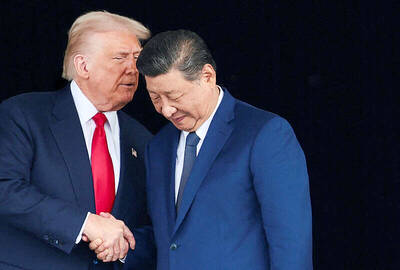Amid public anger about plans to increase National Health Insurance (NHI) premiums, Department of Health (DOH) Minister Yeh Ching-chuan (葉金川) yesterday called a halt to the proposal, saying it had come at a bad time.
The proposed plan, known as the “1.5 Generation NHI Act,” would require individuals to pay a supplementary premium if they earn more than NT$180,000 (US$5,200) per year in non-salaried income. The Bureau of National Health Insurance said the plan would affect about 2.2 million people who earn large amounts of non-salary income from sources such as year-end bonuses, stocks, dividends, bank interest and rent.
At the end of last year, the health insurance fund suffered a deficit of NT$28 billion, a financial gap that would widen to NT$60 billion by the end of this year if the bureau does not do something about it, Bureau of National Health Insurance chief executive officer Chu Tzer-ming (朱澤民) said.
The bureau had hoped to increase the fund’s revenue by NT$44.4 billion per year under the proposed plan, which has been met with widespread criticism because of the global economic climate.
Yeh told a press conference yesterday that the plan would not come into effect this year, as it was “bad timing” to talk about financing the fund with increased premiums while individuals and businesses are all feeling the pressure from the global economic downturn.
“Maybe by the latter half of this year the economy will improve and everyone will be in a better mood to talk about [the plan],” he said. “With the economy doing so poorly right now, everyone would object. Supplementary premiums are only one of the many ways we can fill the fund’s financial gap.”
One option would be to raise the tobacco health and welfare surcharge from the current NT$10 to NT$20 per pack of cigarettes. However, Yeh said this would only cut the fund’s deficit to NT$48 billion, which is still NT$8 billion more than his goal of NT$40 billion.
Yeh said the bureau should seek to improve the fund’s financial condition by improving the process of approving drugs for NHI coverage and actively reviewing medical institutions for NHI violations.
Critics dismissed the idea of financing the fund by raising the tobacco surcharge.
“Isn’t this telling smokers to save the fund by smoking?” said Eva Teng (滕西華), spokesperson of the National Health Insurance Civic Surveillance Alliance. “It would be impossible to put the plan into effect by the end of this year anyway.”
Teng said the department was playing word games with the public in an attempt to put the matter to rest.
Meanwhile, Yeh said the amount in NHI subsidies owed by local governments would be dealt with as per the Regulations for Allotment of Centrally Funded Tax Revenues (中央統籌分配稅款管理辦法).
“After the amendment [of the National Health Insurance Act (全民健康保險法)], the subsidy should be paid for by the central government … but the local governments will still have to pay what they already owe,” he said.
Bureau statistics showed that local governments owe subsidy debts totaling NT$53.9 billion, with Taipei City Government alone owing NT$29.1 billion.
Premier Liu Chao-shiuan (劉兆玄) yesterday urged the DOH to re-evaluate the timetable for its premium hikes.
Government Information Office Minister Su Jun-pin (蘇俊賓) said the premier had asked the DOH to reconsider its plan to collect supplementary premiums.
Su said the premier had expressed concern to the department after the public reacted negatively to the plan.
The premier said the DOH should deal with the national health insurance system’s deficit “more thoroughly” and reconsider whether it was appropriate to push the planned hikes now.
When asked for comment, Chinese Nationalist Party (KMT) caucus deputy secretary-general Lo Shu-lei (羅淑蕾) said the DOH had made the right decision by suspending the plan.
Lo said it was inappropriate to require people who had extra income to pay additional premiums as they also payed income tax.
The deficit would never be resolved unless the National Health Insurance Bureau thoroughly reviews the flaws in the insurance system, Lo said.
ADDITIONAL REPORTING BY FLORA WANG

CALL FOR SUPPORT: President William Lai called on lawmakers across party lines to ensure the livelihood of Taiwanese and that national security is protected President William Lai (賴清德) yesterday called for bipartisan support for Taiwan’s investment in self-defense capabilities at the christening and launch of two coast guard vessels at CSBC Corp, Taiwan’s (台灣國際造船) shipyard in Kaohsiung. The Taipei (台北) is the fourth and final ship of the Chiayi-class offshore patrol vessels, and the Siraya (西拉雅) is the Coast Guard Administration’s (CGA) first-ever ocean patrol vessel, the government said. The Taipei is the fourth and final ship of the Chiayi-class offshore patrol vessels with a displacement of about 4,000 tonnes, Lai said. This ship class was ordered as a result of former president Tsai Ing-wen’s (蔡英文) 2018

‘SECRETS’: While saying China would not attack during his presidency, Donald Trump declined to say how Washington would respond if Beijing were to take military action US President Donald Trump said that China would not take military action against Taiwan while he is president, as the Chinese leaders “know the consequences.” Trump made the statement during an interview on CBS’ 60 Minutes program that aired on Sunday, a few days after his meeting with Chinese President Xi Jinping (習近平) in South Korea. “He [Xi] has openly said, and his people have openly said at meetings, ‘we would never do anything while President Trump is president,’ because they know the consequences,” Trump said in the interview. However, he repeatedly declined to say exactly how Washington would respond in

WARFARE: All sectors of society should recognize, unite, and collectively resist and condemn Beijing’s cross-border suppression, MAC Minister Chiu Chui-cheng said The number of Taiwanese detained because of legal affairs by Chinese authorities has tripled this year, as Beijing intensified its intimidation and division of Taiwanese by combining lawfare and cognitive warfare, the Mainland Affairs Council (MAC) said yesterday. MAC Minister Chiu Chui-cheng (邱垂正) made the statement in response to questions by Democratic Progressive Party (DPP) Legislator Puma Shen (沈柏洋) about the government’s response to counter Chinese public opinion warfare, lawfare and psychological warfare. Shen said he is also being investigated by China for promoting “Taiwanese independence.” He was referring to a report published on Tuesday last week by China’s state-run Xinhua news agency,

‘NOT SUBORDINATE’: Only Taiwanese can decide the nation’s future, and people preserving their democratic way of life is not a provocation, President William Lai said Taiwan does not want China’s “one country, two systems,” and must uphold its freedom and democracy as well as resolve to defend itself, President William Lai (賴清德) said yesterday, rejecting Beijing’s latest bid to bring the country under Chinese control. The president made the remarks while attending a commissioning ceremony for Taiwan’s first battalion of M1A2T Abrams tanks in Hsinchu County’s Hukou Township (湖口). The tanks are made by General Dynamics, a major US defense contractor. China this week said it “absolutely will not” rule out using force over Taiwan, striking a much tougher tone than a series of articles in state media